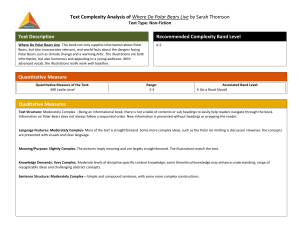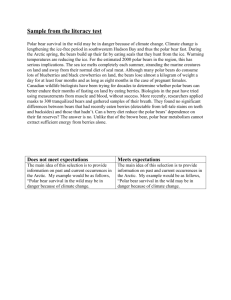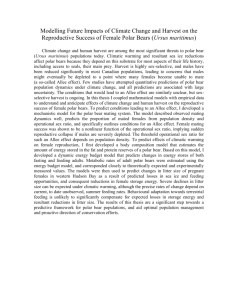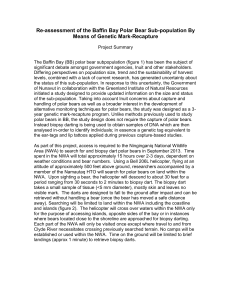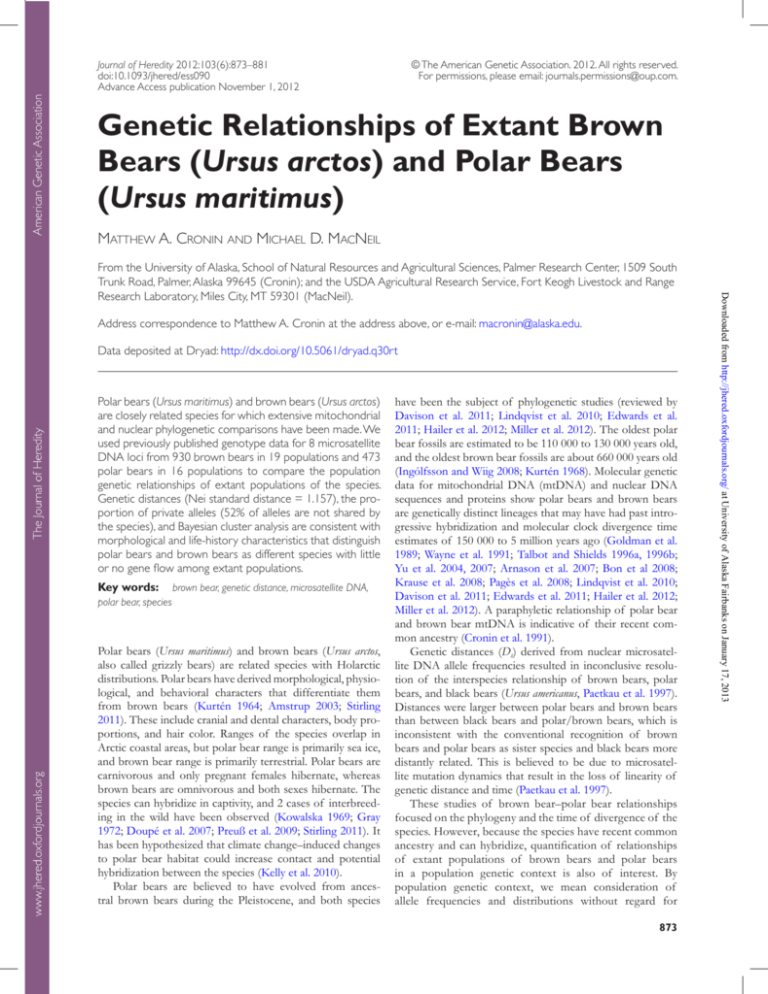
Journal of Heredity 2012:103(6):873–881
doi:10.1093/jhered/ess090
Advance Access publication November 1, 2012
© The American Genetic Association. 2012. All rights reserved.
For permissions, please email: journals.permissions@oup.com.
Genetic Relationships of Extant Brown
Bears (Ursus arctos) and Polar Bears
(Ursus maritimus)
Matthew A. Cronin and Michael D. MacNeil
Address correspondence to Matthew A. Cronin at the address above, or e-mail: macronin@alaska.edu.
Data deposited at Dryad: http://dx.doi.org/10.5061/dryad.q30rt
Polar bears (Ursus maritimus) and brown bears (Ursus arctos)
are closely related species for which extensive mitochondrial
and nuclear phylogenetic comparisons have been made. We
used previously published genotype data for 8 microsatellite
DNA loci from 930 brown bears in 19 populations and 473
polar bears in 16 populations to compare the population
genetic relationships of extant populations of the species.
Genetic distances (Nei standard distance = 1.157), the proportion of private alleles (52% of alleles are not shared by
the species), and Bayesian cluster analysis are consistent with
morphological and life-history characteristics that distinguish
polar bears and brown bears as different species with little
or no gene flow among extant populations.
Key words: brown bear, genetic distance, microsatellite DNA,
polar bear, species
Polar bears (Ursus maritimus) and brown bears (Ursus arctos,
also called grizzly bears) are related species with Holarctic
distributions. Polar bears have derived morphological, physiological, and behavioral characters that differentiate them
from brown bears (Kurtén 1964; Amstrup 2003; Stirling
2011). These include cranial and dental characters, body proportions, and hair color. Ranges of the species overlap in
Arctic coastal areas, but polar bear range is primarily sea ice,
and brown bear range is primarily terrestrial. Polar bears are
carnivorous and only pregnant females hibernate, whereas
brown bears are omnivorous and both sexes hibernate. The
species can hybridize in captivity, and 2 cases of interbreeding in the wild have been observed (Kowalska 1969; Gray
1972; Doupé et al. 2007; Preuß et al. 2009; Stirling 2011). It
has been hypothesized that climate change–induced changes
to polar bear habitat could increase contact and potential
hybridization between the species (Kelly et al. 2010).
Polar bears are believed to have evolved from ancestral brown bears during the Pleistocene, and both species
have been the subject of phylogenetic studies (reviewed by
Davison et al. 2011; Lindqvist et al. 2010; Edwards et al.
2011; Hailer et al. 2012; Miller et al. 2012). The oldest polar
bear fossils are estimated to be 110 000 to 130 000 years old,
and the oldest brown bear fossils are about 660 000 years old
(Ingólfsson and Wiig 2008; Kurtén 1968). Molecular genetic
data for mitochondrial DNA (mtDNA) and nuclear DNA
sequences and proteins show polar bears and brown bears
are genetically distinct lineages that may have had past introgressive hybridization and molecular clock divergence time
estimates of 150 000 to 5 million years ago (Goldman et al.
1989; Wayne et al. 1991; Talbot and Shields 1996a, 1996b;
Yu et al. 2004, 2007; Arnason et al. 2007; Bon et al 2008;
Krause et al. 2008; Pagès et al. 2008; Lindqvist et al. 2010;
Davison et al. 2011; Edwards et al. 2011; Hailer et al. 2012;
Miller et al. 2012). A paraphyletic relationship of polar bear
and brown bear mtDNA is indicative of their recent common ancestry (Cronin et al. 1991).
Genetic distances (Ds) derived from nuclear microsatellite DNA allele frequencies resulted in inconclusive resolution of the interspecies relationship of brown bears, polar
bears, and black bears (Ursus americanus, Paetkau et al. 1997).
Distances were larger between polar bears and brown bears
than between black bears and polar/brown bears, which is
inconsistent with the conventional recognition of brown
bears and polar bears as sister species and black bears more
distantly related. This is believed to be due to microsatellite mutation dynamics that result in the loss of linearity of
genetic distance and time (Paetkau et al. 1997).
These studies of brown bear–polar bear relationships
focused on the phylogeny and the time of divergence of the
species. However, because the species have recent common
ancestry and can hybridize, quantification of relationships
of extant populations of brown bears and polar bears
in a population genetic context is also of interest. By
population genetic context, we mean consideration of
allele frequencies and distributions without regard for
873
Downloaded from http://jhered.oxfordjournals.org/ at University of Alaska Fairbanks on January 17, 2013
From the University of Alaska, School of Natural Resources and Agricultural Sciences, Palmer Research Center, 1509 South
Trunk Road, Palmer, Alaska 99645 (Cronin); and the USDA Agricultural Research Service, Fort Keogh Livestock and Range
Research Laboratory, Miles City, MT 59301 (MacNeil).
Journal of Heredity 2012:103(6)
Materials and Methods
We obtained individual animal genotypes for 8 microsatellite loci from previous analyses of 19 populations of North
American brown bears (Craighead et al. 1995; Paetkau et al.
1997, 1998a, 1998b; Cronin et al. 1999, 2005), 16 worldwide
populations of polar bears (Paetkau et al. 1995, 1997, 1999),
and 1 population of black bears (U. americanus, Paetkau et al.
1997, Table 1, Figure 1). The data were kindly provided by
D. Paetkau (Wildlife Genetics International, Nelson, BC,
Canada). Data for more than 8 loci exist for some populations of both species, but we limited the analysis to data for
8 microsatellite loci from North American brown bears and
polar bears worldwide because genotype data generated in
the same laboratory was available for these loci and populations. This avoids the potential problem of different microsatellite allele identification in different laboratories.
The data we used slightly differ from those in the original studies. Four animals were deleted from the Western
Brooks Range brown bear population (Craighead et al.
1995; Anonymous 2006), and 6 brown bears were sampled
twice, once in each of 2 adjacent populations including 4
bears that were captured in both the East Slope and West
Slope Alberta populations and 2 bears that were sampled in
both the Anderson Mts. and Paulatuk Northwest Territories
874
populations (Paetkau D, personal communication). We
included these animals in both adjacent populations for
our analysis. The data also included combining brown bear
samples from Baranof and Chichikof islands in southeast
Alaska (Paetkau et al. 1998a) and polar bear samples from the
Laptev Sea were included in the Chukchi Sea or Franz Josef
L-Novaja Z populations (Paetkau et al. 1999). Populations,
sample sizes, and locations are shown in Table 1 and Figure 1.
The laboratory methods for 8 microsatellite loci (G1A,
G10B, G10C, G10D, G10L, G10M, G10P, G10X) and
analyses of Hardy–Weinberg equilibrium and linkage disequilibrium are described in the original studies (Table 1).
We calculated the mean number of alleles per locus (A),
observed heterozygosity (Ho), and expected heterozygosity
(He) with the Microsatellite Toolkit program (Park 2001).
Allele frequencies were determined from genotypes and
used to calculate allelic richness (AR) and pair-wise Fst
between populations (Weir and Cockerham 1984) with the
F-STAT program (Goudet 1995). We calculated genetic
distance (Ds Nei 1972) for each pair of populations from
the allele frequencies with the GENDIST program in the
PHYLIP 3.62 software package (Felsenstein 2004). Paetkau
et al. (1997) previously found that Ds performed well for
comparing bear populations with microsatellites.
We calculated Ds and Fst between each population pair and
then calculated the average of each measure for all interspecies population pairs and intraspecies population pairs. We
determined the numbers of alleles restricted to 1 species (i.e.,
private alleles) and numbers of alleles shared by both species. These analyses were done for the entire data set of 19
brown bear and 16 polar bear populations and for a subset of
7 Arctic brown bear (Western Brooks Range, Prudhoe Bay,
Arctic National Wildlife Refuge, Anderson Mts., Richardson
Mts., Paulatuk, Coppermine Northwest Territories) and 6
polar bear populations (Chukchi Sea, South Beaufort Sea,
North Beaufort Sea, Lancaster Sound, Viscount Melville
Sound, M’Clintock Channel) with potentially contiguous
ranges (Table 1, Figure 1).
Ds values were used in cluster analysis with the FITCH
program (Fitch and Margoliash 1967) in PHYLIP to generate
a dendrogram with the black bear population as an out-group
and 1000 bootstrap replicates of the allele frequencies with
the SEQBOOT program in PHYLIP.
We used the Bayesian clustering method with no a
priori assignment of individuals to populations with the
STRUCTURE program (Pritchard et al. 2000; Falush et al.
2003). We ran STRUCTURE for K = 1 through K= 36 (where
K= number of assumed populations) with a 20 000 burn-in
period and 300 000 Markov chain Monte Carlo repetitions
with the no admixture model. We did 10 replicates of the
procedure for each K value. The log probability of data
LnP(D) and the statistic ΔK were estimated for each value of
K. LnP(D) values are negative, and the value closest to 0 can
be used to infer the most probable K, except in cases where
population structure results in small differences among
LnP(D) values (Pritchard et al. 2010). ΔK quantifies the rate
of change of LnP(D) between successive K values, and the
Downloaded from http://jhered.oxfordjournals.org/ at University of Alaska Fairbanks on January 17, 2013
molecular sequence divergences of alleles. For example,
despite mtDNA sequence paraphyly in polar bears and
brown bears, different haplotypes occur in each species
(Krause et al. 2008; Edwards et al. 2011). From a population
genetic perspective, extant populations of each species have
different mtDNA gene pools regardless of gene phylogeny
and past introgressive hybridization. Interspecies nuclear
population genetic relationships have not been characterized
for multiple individuals and populations of each species.
The most extensive study of nuclear gene sequences in
these species included a wide geographic distribution, but
sample sizes of <60 individuals of each species (Hailer
et al. 2012; Miller et al. 2012). Interspecies comparisons
of microsatellites have been restricted to the study noted
above, which included only 2 polar bear populations and 8
brown bear populations (Paetkau et al. 1997). Other studies
of microsatellites only assessed intraspecies population
structure of polar bears and brown bears (e.g., Paetkau et al.
1995, 1998a, 1998b, 1999).
In this study, we assessed the genetics of extant populations with 8 nuclear microsatellite loci for 1403 bears including
brown bears across their North American range, polar bears
across their worldwide range, and areas where the species’
ranges are potentially contiguous. Our objective was to assess
the interspecies population genetic relationships of brown
bears and polar bears and address the question: do extant
populations of brown bears and polar bears have different
nuclear gene pools? Our approach included quantifying the
distribution of private and shared alleles in each species and
assessing genetic distances and Bayesian clustering patterns.
Cronin and MacNeil • Genetic Distances of Polar Bears and Brown Bears
Table 1 Sampling locations and microsatellite DNA measures of variation for North American brown bears and worldwide polar bears
Location
N
A
AR
Ho
He
Mainland Coast (MC)
Admiralty Island (AI)
Baranof & Chichikof Islandsa (B&C)a
Kluane (KL)
15
30
35
50
5.63
4.88
4.25
7.38
5.556
4.395
3.592
6.1764
0.6167
0.6458
0.4929
0.7875
Izembek (IZ)
Kuskokwim Mts. (KK)
14
55
4
4
0.5357
6.13 4.8971 0.7
Kodiak Island (KI)
34
2.13 1.8918 0.2978
Central Alaska
Arctic North America
North Alaska Range (NAR)
Prudhoe Bayb (PB)
Arctic Nat. Wildlife Refb (ANWR)
Western Brooks Rangeb (WBR)
28
78
24
148
6.63
8.13
6.63
7.63
6.0825
6.0753
6.0546
5.8678
Northwest Territories
Canada
Richardson Mts.b (RMt)
119
7.5
6.0693 0.7658
Anderson Mts.b (AC)
Paulatukb (PK)
Coppermineb (CM)
23
58
36
5.38 4.8071 0.6848
5.75 4.8831 0.6573
5.75 4.16713 0.6181
0.7569 Paetkau et al. 1998a
0.6278
0.496
0.7613 Paetkau et al. 1998a,
1998b
0.5324 Paetkau et al. 1998a
0.6819 Paetkau et al. 1998a,
1998b
0.265 Paetkau et al. 1997,
1998a, 1998b
0.7794 Paetkau et al. 1998a
0.754 Cronin et al. 1999, 2005
0.7635 Paetkau et al. 1997
0.7495 Craighead et al. 1995,
Paetkau et al. 1997,
1998a, 1998b
0.7554 Paetkau et al. 1997,
1998b
0.6699 Paetkau et al. 1997
0.6503 Paetkau et al. 1997,
1998b
0.6034
East Slope (ES)
West Slope (WS)
Northern US Rocky Mts. Yellowstone Nat. Park (YNP)
Flathead River (FR)
45
41
57
40
7
6.38
4.38
6.5
5.6333
5.2275
3.8533
5.4163
0.6444
0.6677
0.5526
0.6938
Brown Bears Average
Polar bears
Southern Canada
48.95 5.90 4.9813
0.6530
0.6696 Paetkau et al. 1998b
0.6775
0.5545 Paetkau et al. 1998b
0.6943 Paetkau et al. 1997,
1998b
0.6549
33
30
30
30
30
30
32
31
31
30
15
31
30
30
30
30
29.56
32
0.6288
0.5917
0.6292
0.6583
0.6083
0.6583
0.5938
0.6371
0.5927
0.7000
0.6583
0.6492
0.675
0.6667
0.6083
0.6458
0.6334
0.7891
0.6338
0.6008
0.6411
0.6364
0.6392
0.6405
0.5845
0.6265
0.61
0.6888
0.6661
0.6503
0.6737
0.6958
0.6323
0.6573
0.6423
0.8201
Brown bears
Southeast Alaska
Yukon Territory
Southwest Alaska
Southwestern Canada
Alberta
Polar Basin
Canadian Arctic
Archepelago
Polar Bears Average
Black bears
West Hudson Bay (WHB)
Davis Strait-Labrador (DS)
Foxe Basin (FB)
South Beaufort Seab (SBS)
Chukchi Seab, c (CS)
North Beaufort Seab (NBS)
Franz Josef Land-Novaja Zc (FN)
Svalbard (SV)
East Greenland (EG)
Lancaster Soundb (LS)
M’Clintock Channelb (MC)
Baffin Bay (BB)
Kane Basin (KB)
Gulf of Boothia (GB)
Viscount-Melville Soundb (VM)
Norwegian Bay (NW)
La Maurice Nat Park Quebec (LM)
5.63
6.13
5.63
5.75
5.63
6.38
6.13
6.5
6.38
6.88
5.25
6.13
6.5
6.25
6
6.38
6.10
8.75
4.9369
5.273
4.9898
5.1735
4.9744
5.4155
4.9925
5.3894
5.3233
5.722
5.1574
5.3128
5.611
5.6105
5.4884
5.6024
5.3108
7.4515
0.7589
0.7369
0.776
0.7745
Original data reference
Paetkau et al. 1995, 1999
Paetkau et al. 1999
Paetkau et al. 1995, 1999
Paetkau et al. 1999
Paetkau et al. 1995, 1999
Paetkau et al. 1999
Paetkau et al. 1999
Paetkau et al. 1999
Paetkau et al. 1999
Paetkau et al. 1999
Paetkau et al. 1999
Paetkau et al. 1999
Paetkau et al. 1999
Paetkau et al. 1999
Paetkau et al. 1999
Paetkau et al. 1997
aSamples
from Baranof and Chichikof Islands combined.
contiguous populations of polar and brown bears.
cSamples from Laptev Sea included in Chukchi Sea or Franz Josef L-Novaja Z. populations.
bPotentially
highest ΔK is the most likely K in situations when K is not
clearly indicated by LnP(D) values (Evanno et al. 2005).
Results
Genotypes of 930 brown bears in 19 populations, 473 polar
bears in 16 populations, and 32 black bears in 1 population
were used to calculate measures of genetic variation (Table 1),
allele frequencies (Supplementary Table 1), and Ds (Table 2,
Supplementary Table 2).
Number of alleles per locus among populations ranged
from 2.13 to 8.13 (average 5.9) in brown bears and 5.25
to 6.88 (average 6.1) in polar bears. Allelic richness ranged
from 1.89 to 6.18 (average 4.98) in brown bears and 4.94 to
5.72 (average 5.31) in polar bears. Observed heterozygosity
875
Downloaded from http://jhered.oxfordjournals.org/ at University of Alaska Fairbanks on January 17, 2013
Population
Journal of Heredity 2012:103(6)
ranged from 0.2978 to 0.7875 (average 0.6530) in brown
bears and 0.5917 to 0.7000 (average 0.6334) in polar bears.
Expected heterozygosity ranged from 0.2650 to 0.7794
(average 0.6549) in brown bears and 0.5845 to 0.6958
(average 0.6423) in polar bears (Table 1). The measures of
variation are particularly low for the isolated Kodiak Island
brown bear population as reported previously (Paetkau
et al. 1997, 1998a, 1998b).
Of 107 total alleles observed for the 8 loci, 56 (0.5234) are
not shared by brown bears and polar bears and 51 (0.4766)
are shared by both species. Of the alleles not shared by the
species (i.e., private alleles), 22 (0.2056) are in polar bears
only and 34 (0.3177) are in brown bears only (Supplementary
Table 1). Average frequency of the private alleles in polar
bears is 0.0849 (standard deviation [SD] = 0.183, range
0.001–0.782), and 14 of 22 (0.636) private alleles are rare
(i.e., frequency < 0.05). Average frequency of the private
alleles in brown bears is 0.0734 (SD = 0.109, range 0.0005
to 0.413), and 21 of 34 (0.618) private alleles are rare.
Average frequency of the alleles shared by both species is
876
0.120 (SD = 0.142, range 0.001–0.672) in polar bears and
0.108 (SD 0.110, range 0.001–0.501) in brown bears. Some
private alleles have limited distribution, including 5 in each
species that occur in only 1 population. Other private alleles
are widely distributed including 4 that occur in all 16 of
the polar bear populations and 3 more that occur in 12–15
of the polar bear populations. Zero private alleles occur
in all 19 of the brown bear populations, 2 occur in 18 of
the brown bear populations, and 12 occur in 12–16 of the
brown bear populations.
The proportion of private alleles are not significantly
different in the subsets of 13 potentially contiguous populations and 22 noncontiguous populations of polar bears
and brown bears (2 proportion z-test, P = 0.5751). The 13
potentially contiguous populations have 92 total alleles, of
which 48 (0.5217) are private alleles, 44 (0.4783) are shared
by the species, 17 (0.1848) are in polar bear only, and 31
(0.3369) are in brown bear only. The 22 noncontiguous
populations have 99 total alleles, of which 53 (0.5354) are
private alleles, 46 (0.4646) are shared by the species, 23
Downloaded from http://jhered.oxfordjournals.org/ at University of Alaska Fairbanks on January 17, 2013
Figure 1. Map of brown bear, polar bear, and black bear sampling locations (population abbreviations described in Table 1).
Cronin and MacNeil • Genetic Distances of Polar Bears and Brown Bears
(0.2323) are in polar bear only, and 30 (0.3030) are in brown
bear only.
The average interspecies Ds between the 16 polar bear populations and the 19 brown bear populations is 1.157. The average interspecies Ds between noncontiguous populations (1.158)
is not significantly different from the average interspecies Ds
between contiguous populations (1.149) of polar bears and
brown bears (P = 0.800, 2-tailed z-test of means). The average interspecies Ds between the polar bear populations and the
black bear populations is 0.952 and between the brown bear
populations and black bear populations is 0.904. When all the
polar bear populations are combined into one group and all
Table 2 Pair-wise genetic distance (Ds and Fst) summary for 19 populations of brown bears, 16 populations of polar bears, and 1
population of black bears
Average genetic
distance, Ds
(Nei 1972)
SD
Brown versus polar, all populations
Brown versus polar, contiguous populations
Brown versus brown
Polar versus polar
Brown versus black
Polar versus black
304
42
171
120
19
16
1.1569
1.1495
0.4546
0.1329
0.9039
0.9521
0.2013
0.2046
0.2552
0.0763
0.2825
0.1199
Range
95%
Confidence
level
Fst
0.7360–1.8150
0.8690–1.661
0.045–1.498
0.0220–0.392
0.6220–1.6090
0.757–1.138
0.0227
0.0638
0.0385
0.0138
0.1362
0.0639
0.2688
0.2392
0.1590
0.0497
0.1759
0.1832
Figure 2. Fitch dendrogram of polar bears, brown bears, and black bears generated with Ds (Nei 1972) genetic distances.
877
Downloaded from http://jhered.oxfordjournals.org/ at University of Alaska Fairbanks on January 17, 2013
Comparison
Number of
population pairs
Journal of Heredity 2012:103(6)
878
bears included) indicates that all polar bears have a 1.0
probability of being in 1 cluster, and all brown bears have
1.0 probability of being in a second cluster.
Discussion
Our results show that 52% of the alleles observed are not
shared by polar bears and brown bears, and the Ds and the
STRUCTURE analysis separate polar bears and brown bears
into different clusters. These data are consistent with other
data showing the species have separate gene pools including
different mtDNA haplotypes, nuclear DNA sequences, morphology, and life history.
Our interspecies Ds are comparable to Ds for other congeneric carnivore species. For example, Ds for 10 microsatellite
loci between allopatric wolf (Canis lupus) in the Northwest
Territories, Canada, and coyote (Canis latrans) in California is
0.444, between wolf and golden jackal (Canis aureus) in Kenya
is 1.031, and between coyote and golden jackal is 1.34 (calculated from allele frequencies in Roy et al. 1994).
Some polar bear and brown bear populations have
contiguous ranges, and it has been suggested that climate
change–induced changes to polar bear sea ice habitat could
increase contact and hybridization between the species (Kelly
et al. 2010). Others have questioned the species status of
polar bears and brown bears because of potential interspecies
hybridization and a paraphyletic mtDNA relationship
(Marris 2007, but see Cronin 2007). Our analysis shows
genetic distances and the proportions of shared and private
alleles between the species are not significantly different
for noncontiguous populations and potentially contiguous
brown bear and polar bear populations, indicating there is
no extensive hybridization in extant populations. DNA
sequences for 14 nuclear genes also indicate there is little
hybridization in extant populations of polar bears and brown
bears (Hailer et al. 2012).
The difference in the Ds between polar bears and brown
bears (i.e., 1.157 for the interpopulation–interspecies average
and 0.873 for combined populations of each species) is primarily because the interpopulation average gives equal weight
to each interpopulation distance regardless of the number
of samples in them, whereas the combined population gives
average weight contributions from each population in proportion to the number of samples in each. For example,
there are 2 brown bear populations with disproportionately
large sample sizes (Western Brooks Range, N =148, and
Richardson Mts., N = 119, Table 1) that have relatively low
interpopulation Ds (average 0.983 and 0.969) with polar bear
populations. This serves to increase the number of brown
bear samples with allele frequencies more similar to those of
polar bears in the combined sample pool, resulting in a lower
Ds. These brown bear populations are contiguous with polar
bear range, and the relatively low Ds could suggest hybridization. However, 2 points argue against this. First, these populations, and the 2 polar bear populations contiguous to them
(South Beaufort Sea, Chukchi Sea) do not have significantly
different proportions of shared alleles than do all of the contiguous populations (2 proportion z-test, P = 0.5514). Second,
Downloaded from http://jhered.oxfordjournals.org/ at University of Alaska Fairbanks on January 17, 2013
the brown bear populations are combined into another group,
the Ds are lower than for the interpopulation averages (polar
vs. brown 0.873, polar vs. black 0.886, brown vs. black 0.651).
The Ds between populations and species are shown graphically in the FITCH tree with branch lengths proportional to
the Ds (Figure 2). The FITCH tree shows the number of
bootstrap replicates that resulted in the topology indicated
for nodes with bootstrap values more than 0.50, and black
bears as the designated out-group. Brown bears and polar
bears occur in separate clusters in both trees. The polar bear
cluster has 99% bootstrap support (995 of 1000 replicates),
and the brown bear cluster has 83% bootstrap support.
Intraspecies Ds are considerably smaller than the interspecies Ds, and Ds are larger among brown bear populations than
among polar bear populations (Table 2). Note the intraspecies relationships depicted in the dendrogram (Figure 2) have
limited reliability as most clusters have bootstrap support less
than 0.5. However, the intraspecies brown bear population
relationships in the FITCH tree are generally consistent with
geographic regions, including clusters in the North American
Arctic, southwest Alaska, southern Canada and the northern
US Rocky Mountains, and southeast Alaska and the adjacent
Yukon Territory. Exceptions are the Admiralty Island population that does not cluster with the other southeast Alaska
populations, and the Kodiak Island population clusters with
the Arctic populations. Intraspecies clusters of polar bears
on the FITCH tree include southern Canada (60% bootstrap support) and polar basin (74% bootstrap support). The
Canadian archipelago populations occur in several clusters,
and the North Beaufort Sea population occurs outside the
other polar basin populations.
Fst estimates are of the same relative magnitude as Ds,
with the average interspecies polar bear–brown bear value
(Fst = 0.2688) greater than the average intraspecies values
(brown bear Fst = 0.1590, polar bear Fst = 0.0497). The
brown bear–polar bear Fst value is also greater than the brown
bear–black bear (Fst = 0.1759) and polar bear–black bear
(Fst = 0.1832) interspecies values (Table 2, Supplementary
Table 2).
The STRUCTURE analysis resulted in LnP(D) values ranging from −45428.3 (K = 1) to −32873.6 (K = 32,
Supplementary Table 3). There is little difference in LnP(D)
values from K = 2–36 and no significantly high value that
would indicate a best K value. This is a common pattern in
natural populations with varying degrees of structure that
may not conform to the STRUCTURE model (Evanno
et al. 2005; Pritchard et al. 2010). The ΔK value for K = 3
was 57.2, and all other ΔK values were substantially lower
(<3.7, Supplementary Table 3), indicating that K= 3 is the
best-supported number of groups. With K = 3, all polar
bears have 1.0 probability of being in 1 cluster, and all
brown bears and black bears have 0.0 probability of being
in this cluster. With K = 3, brown bear populations have
0.000–0.999 probability of being in a second cluster and
0.001–1.000 probability of being in a third cluster. Black
bears have 0.991 probability of being in the second cluster and 0.009 probability of being in the third cluster.
A STRUCTURE analysis with K = 2 (with or without black
Cronin and MacNeil • Genetic Distances of Polar Bears and Brown Bears
nuclear gene pools as indicated by our analysis. Likewise,
paraphyletic mtDNA phylogeny does not detract from the
fact that there are different mtDNA haplotypes and distinct
nuclear DNA lineages in each species. These genetic data
combined with derived morphological, physiological, behavioral, and life-history characters in polar bears, and very rare
interbreeding in nature supports recognition of polar bears
and brown bears as different species under the biological species (Mayr 1963), genetic species (Baker and Bradley
2006), and phylogenetic species (Eldredge and Cracraft 1980)
concepts.
Future assessment of the relationship of polar bears
and brown bears will be aided by many new genetic markers from genome-sequencing projects (BGI 2011; Medrano
JF, University of California Davis, personal communication;
Miller et al. 2012). Single nucleotide polymorphisms and
nuclear DNA sequences in general may be particularly useful
as they may exhibit less homoplasy than microsatellite loci
(Coates et al. 2009).
Supplementary Material
Supplementary Tables 1–4 can be found at http://www.
jhered.oxfordjournals.org/. The genotype data reported in
this paper has been deposited in the Dryad data archive.
Funding
State of Alaska Department of Commerce, Community, and
Economic Development.
Acknowledgments
D. Paetkau, Wildlife Genetics International Inc. provided the genotype
data for most of the populations used in this study. V. R. Leesburg did
the Structure analyses and N. Vu made the figures. Useful comments were
provided by M. E. Rout, N. Vu, S. Crockford, three anonymous reviewers,
and the associate editor. The U.S. Department of Agriculture Agricultural
Research Service Fort Keogh Livestock and Range Research Laboratory
provided offices and analytical support for MAC.
References
Amstrup SC. 2003. Polar Bear, Ursus maritimus. In: Feldhamer GA,
Thompson BC, Chapman JA, editors. Wild mammals of North America:
biology, management, and conservation. Baltimore (MD): Hopkins
University Press. p. 587–610.
Anonymous. 2006. Erratum. J Hered. 97:NP.
Arnason U, Gullberg A, Janke A, Kullberg M. 2007. Mitogenomic analyses
of caniform relationships. Mol Phylogenet Evol. 45:863–874.
Baker RJ, Bradley RD. 2006. Speciation in mammals and the genetic species
concept. J Mammal. 87:643–662.
BGI. 2011. BGI 10K sequencing project mammals, carnivores; [cited 2011
Nov 2]. Available from: http://en.genomics.cn/navigation/show_navigation.action?navigation.id=220
Bon C, Caudy N, de Dieuleveult M, Fosse P, Philippe M, Maksud F,
Beraud-Colomb E, Bouzaid E, Kefi R, Laugier C, et al. 2008. Deciphering
the complete mitochondrial genome and phylogeny of the extinct cave
bear in the Paleolithic painted cave of Chauvet. Proc Natl Acad Sci USA.
105:17447–17452.
879
Downloaded from http://jhered.oxfordjournals.org/ at University of Alaska Fairbanks on January 17, 2013
some noncontiguous brown bear and polar bear populations
also have relatively low Ds (Supplementary Table 2).
Our analysis detected similar levels of genetic variation in
polar bears and brown bears (Table 1) and a higher level of
intraspecies population subdivision of brown bears than polar
bears. Previous studies of intraspecies microsatellite variation
using more than 8 loci have better resolution than our analysis
and have shown that brown bears occur in geographically
separate populations with limited gene flow among some
areas (Paetkau et al. 1997, 1998a, 1998b; Cronin et al. 1999,
2005; Miller and Waits 2003; Jackson et al. 2008), whereas
polar bear populations are relatively homogeneous over
geography (Paetkau et al. 1995, 1997, 1999; Cronin et al. 2006;
Zeyl et al. 2009) although there may be localized structure
(Crompton et al. 2008). MtDNA variation also shows
considerable geographic structure of brown bear populations
(Talbot and Shields 1996b; Waits et al. 1998; Shields et al.
2000; Davison et al. 2011). These patterns are probably due to
the lack of geographic barriers to gene flow across the polar
bear range of Arctic sea ice, whereas the brown bear range
has geographic barriers (e.g., mountain ranges, water bodies,
human settlements) that restrict gene flow.
Two characteristics of genetic data have complicated
assessing the relationships of polar bears and brown bears.
First, the species have a paraphyletic mtDNA phylogeny,
indicating some brown bears have mtDNA related to that
of polar bears. However, different mtDNA haplotypes occur
in each species (Krause et al. 2008; Edwards et al. 2011), and
extant populations of each species have different mtDNA
gene pools.
Second, microsatellite Ds between polar bears and brown
bears are higher than those between either of them and black
bears. This is inconsistent with the recognition of polar bears
and brown bears as sister species and black bears are more
distantly related. Paetkau et al. (1997) showed that genetic distances (including Ds) plateau at a maximum level after short
evolutionary time periods (3000–30 000 generations) due
to constraints on allele size and a rapid mutation rate. This
suggests that microsatellite alleles are shared by the 3 species because of homoplasy, not identity by descent. Similarly,
Wayne et al. (1991) found with 2-dimensional protein electorphoresis data for carnivores (including brown bears and polar
bears) that there is less genetic change per unit time with
increasing Ds. This indicates that estimation of interspecies
phylogeny and divergence times with rapidly evolving markers such as microsatellites may be inappropriate, although the
average square distance (ASD) has been demonstrated to be
linear with time to about 2 million years ago (Sun et al. 2009).
Regardless, our data for only 8 loci are too limited to reliably
assess the species phylogeny and divergence times with ASD.
Other studies of molecular phylogeny show a wide range of
divergence times (150 000–5 million years ago) of polar bears
and brown bears (Talbot and Shields 1996b; Waits et al. 1999;
Yu et al. 2004, 2007; Lindqvist et al. 2010; Davison et al. 2011;
Edwards et al. 2011; Hailer et al. 2012; Miller et al. 2012).
The uncertainty of the polar bear–brown bear–black bear
phylogeny and divergence times does not prevent recognition that extant polar bears and brown bears have different
Journal of Heredity 2012:103(6)
Coates BS, Sumerford DV, Miller NJ, Kim KS, Sappington TW, Siegfried
BD, Lewis LC. 2009. Comparative performance of single nucleotide polymorphism and microsatellite markers for population genetic analysis. J
Hered. 100:556–564.
Jackson JV, Talbot SL, Farley S. 2008. Genetic characterization of Kenai
brown bears (Ursus arctos): microsatellite and mitochondrial DNA control
region variation in brown bears of the Kenai Peninsula, south central Alaska.
Can J Zool. 86:756–764.
Craighead L, Paetkau D, Reynolds HV, Vyse ER, Strobeck C. 1995.
Microsatellite analysis of paternity and reproduction in Arctic grizzly bears.
J Hered. 86:255–261.
Kelly BP, Whiteley A, Tallmon D. 2010. The Arctic melting pot. Nature.
468:891.
Crompton A, Obbard ME, Petersen SD, Wilson PJ. 2008. Population genetic
structure in polar bears (Ursus maritimus) from Hudson Bay, Canada: implications for future climate change. Biol Conservation. 141:2528–2539.
Cronin MA. 2007. Limitations of molecular genetics in conservation.
Nature. 447:638.
Cronin, MA, Amstrup SC, Garner GW, Vyse ER. 1991. Interspecific
and intraspecific mitochondrial DNA variation in North American bears
(Ursus). Can J Zool. 69:2985–2992.
Cronin M, Shideler R, Hechtel J, Strobeck C, Paetkau D. 1999. Genetic
relationships of grizzly bears (Ursus arctos) in the Prudhoe Bay region of
Alaska: inference from microsatellite DNA, mitochondrial DNA, and field
observations. J Hered. 90:622–628.
Cronin MA, Shideler R, Waits LP, Nelson RJ. 2005. Genetic variation and
relatedness in grizzly bears (Ursus arctos) in the Prudhoe Bay region and
adjacent areas in northern Alaska. Ursus. 16:70–84.
Davison J, Ho SYW, Brayk SC, Korsten M, Tammeleht E, Hindrikson M,
Østbye K, Østbye E, Lauritzen S-E, Austin J, et al. 2011. Late-Quaternary
biogeographic scenarios for the brown bear (Ursus arctos), a wild mammal
model species. Quat Sci Reviews. 30:418–430.
Doupé JP, England JH, Furze M, Paetkau D. 2007. Most northerly observation of a grizzly bear (Ursus arctos) in Canada: Photographic and DNA
evidence from Melville Island, Northwesat Territories. Arctic. 60:271–276.
Edwards CJ, Suchard MA, Lemey P, Welch JJ, Barnes I, Fulton TL, Barnett
R, O’Connell TC, Coxon P, Monaghan N, et al. 2011. Ancient hybridization and an Irish origin for the modern polar bear matriline. Curr Biol.
21:1251–1258.
Eldredge N, Cracraft J. 1980. Phylogenetic patterns and the evolutionary
process. New York: Columbia University Press.
Evanno G, Regnaut S, Goudet J. 2005. Detecting the number of clusters of
individuals using the software STRUCTURE: a simulation study. Mol Ecol.
14:2611–2620.
Falush D, Stephens M, Pritchard JK. 2003. Inference of population structure using multilocus genotype data: linked loci and correlated allele frequencies. Genetics. 164:1567–1587.
Felsenstein, J. 2004. PHYLIP (Phylogeny Inference Package) version 3.6.
Distributed by the author. Seattle: Department of Genome Sciences,
University of Washington.
Krause J, Unger T, Noçon A, Malaspinas AS, Kolokotronis SO, Stiller M,
Soibelzon L, Spriggs H, Dear PH, Briggs AW, et al. 2008. Mitochondrial
genomes reveal an explosive radiation of extinct and extant bears near the
Miocene-Pliocene boundary. BMC Evol Biol. 8:220.
Kurtén B. 1964. The evolution of the polar bear, Ursus maritimus (Phipps).
Acta Zool Fenn. 108:1–30.
Kurtén B. 1968. Pleistocene mammals of Europe. London: Weidenfeld and
Nicolson.
Lindqvist C, Schuster SC, Sun Y, Talbot SL, Qi J, Ratan A, Tomsho LP,
Kasson L, Zeyl E, Aars J, et al. 2010. Complete mitochondrial genome of
a Pleistocene jawbone unveils the origin of polar bear. Proc Natl Acad Sci
USA. 107:5053–5057.
Marris E. 2007. The species and the specious. Nature. 446:250–253.
Mayr E. 1963. Populations, species, and evolution. Cambridge (MA):
Belknap Press, Harvard University Press.
Miller CR, Waits LP. 2003. The history of effective population size and
genetic diversity in the Yellowstone grizzly (Ursus arctos): implications for
conservation. Proc Natl Acad Sci USA. 100:4334–4339.
Miller W, Schuster SC, Welch AJ, Ratan A, Bedoya-Reina OC, Zhao F, Kim
HL, Burhans RC, Drautz DI, Wittekindt NE, et al. 2012. Polar and brown
bear genomes reveal ancient admixture and demographic footprint of past
climate change. Proc Nat Acad Sci USA. 109:E2382–E2390.
Nei M. 1972. Genetic distance between populations. Am Nat. 106:283–292.
Paetkau D, Amstrup SC, Born EW, Calvert W, Derocher AE, Garner GW,
Messier F, Stirling I, Taylor M, Wiig O, et al. 1999. Genetic structure of the
world’s polar bear populations. Mol Ecol. 8:1571–1584.
Paetkau D, Calvert W, Stirling I, Strobeck C. 1995. Microsatellite analysis of
population structure in Canadian polar bears. Mol Ecol. 4:347–354.
Paetkau D, Shields GF, Strobeck C. 1998a. Gene flow between insular,
coastal and interior populations of brown bears in Alaska. Mol Ecol.
7:1283–1292.
Paetkau D, Waits LP, Clarkson PL, Craighead L, Strobeck C. 1997. An empirical evaluation of genetic distance statistics using microsatellite data from
bear (Ursidae) populations. Genetics. 147:1943–1957.
Paetkau D, Waits LP, Craighead L, Clarkson PL, Strobeck C. 1998b. Dramatic
variation in genetic diversity across the range of North American brown
bears. Conserv Biol. 12:418–429.
Fitch WM, Margoliash E. 1967. Construction of phylogenetic trees. Science.
155:279–284.
Pagès M, Calvignac S, Klein C, Paris M, Hughes S, Hänni C. 2008. Combined
analysis of fourteen nuclear genes refines the Ursidae phylogeny. Mol
Phylogenet Evol. 47:73–83.
Goldman D, Giri PR, O’Brien SJ. 1989. Molecular genetic-distance estimates
among the Ursidae as indicated by one and two-dimensional protein electrophoresis. Evolution. 43:282–295.
Park SDE. 2001. Trypanotolerance in West African cattle and the population
genetic effects of selection [PhD dissertation]. [Dublin (Ireland)]: University
of Dublin.
Goudet J. 1995. FSTAT (version 1.2): a computer program to calculate
F-statistics. J Hered. 86:485–486.
Preuß A, Gansloßer U, Purschke G, Magiera U. 2009. Bear-hybrids: behavior
and phenotype. Zool Garten NF. 78:204–220.
Gray AP. 1972. Mammalian hybrids. Farnham Royal, Slougth England:
Commonwealth Agricultural Bureaux.
Pritchard JK, Stephens M, Donnelly P. 2000. Inference of population structure using multilocus genotype data. Genetics. 155:945–959.
Hailer F, Kutschera VE, Hallström BM, Klassert D, Fain SR, Leonard JA,
Arnason U, Janke A. 2012. Nuclear genomic sequences reveal that polar
bears are an old and distinct bear lineage. Science. 336:344–347.
Pritchard JK, Wen X, Falush D. 2010. Documentation for Structure software
Version 2.3. [Cited 2011 Jun 17]. Available from: http://pritch.bsd.uchicago.
edu/structure.html.
Ingólfsson Ó, Wiig Ø. 2008. Late Pleistocene fossil find in Svalbard: the oldest remains of a polar bear (Ursus maritimus) Phipps, 1744) ever discovered.
Polar Res. 28:455–462.
Roy MS, Geffen E, Smith D, Ostrander EA, Wayne RK. 1994. Patterns
of differentiation and hybridization in North American wolflike canids,
revealed by analysis of microsatellite loci. Mol Biol Evol. 11:553–570.
880
Downloaded from http://jhered.oxfordjournals.org/ at University of Alaska Fairbanks on January 17, 2013
Cronin MA, Amstrup SC, Scribner KT. 2006. Microsatellite DNA and mitochondrial DNA variation in polar bears in the Beaufort and Chukchi seas,
Alaska. Can J Zool. 84:655–660.
Kowalska Z. 1969. A note on bear hybrids Thalarctos maritimus X Ursus
arctos at Lodz Zoo. International Zoo Yearbook. 9:89.
Cronin and MacNeil • Genetic Distances of Polar Bears and Brown Bears
Shields GF, Adams D, Garner G, Labelle M, Pietsch J, Ramsay M, Schwartz
C, Titus K, Williamson S. 2000. Phylogeography of mitochondrial DNA
variation in brown bears and polar bears. Mol Phylogenet Evol. 15:319–326.
Stirling I. 2011. Polar bears: the natural history of a threatened species.
Brighton (MA): Fitzhenry & Whiteside.
Sun JX, Mullikin JC, Patterson N, Reich DE. 2009. Microsatellites are molecular clocks that support accurate inferences about history. Mol Biol Evol.
26:1017–1027.
Talbot SL, Shields GF. 1996a. Phylogeography of brown bears (Ursus arctos)
of Alaska and paraphyly within the Ursidae. Mol Phylogenet Evol. 5:477–494.
Talbot SL, Shields GF. 1996b. A phylogeny of the bears (Ursidae) inferred
from complete sequences of three mitochondrial genes. Mol Phylogenet
Evol. 5:567–575.
Waits LP, Sullivan J, O’Brien SJ, Ward RH. 1999. Rapid radiation events in
the family Ursidae indicated by likelihood phylogenetic estimation from multiple fragments of mtDNA. Mol Phylogenet Evol. 13:82–92.
Weir BS, Cockerham CC. 1984. Estimating F-statistics for the analysis of
population structure. Evolution. 38:1358–1370.
Yu L, Li QW, Ryder OA, Zhang YP. 2004. Phylogeny of the bears
(Ursidae) based on nuclear and mitochondrial genes. Mol Phylogenet Evol.
32:480–494.
Yu L, Li YW, Ryder OA, Zhang YP. 2007. Analysis of complete mitochondrial genome sequences increases phylogenetic resolution of bears
(Ursidae), a mammalian family that experienced rapid speciation. BMC Evol
Biol. 7:198.
Zeyl E, Aars J, Ehrich D, Wiig O. 2009. Families in space: relatedness in
the Barents Sea population of polar bears (Ursus maritimus). Mol Ecol.
18:735–749.
Received January 2, 2012; Revised September 7, 2012;
Accepted September 24, 2012
Downloaded from http://jhered.oxfordjournals.org/ at University of Alaska Fairbanks on January 17, 2013
Waits LP, Talbot SL, Ward RH, Shields GF. 1998. Mitochondrial DNA phylogeography of the North American brown bear and implications for conservation. Conserv Biol. 12:408–417.
Wayne RK, Van Valkenburgh B, O’Brien SJ. 1991. Molecular distance and
divergence time in carnivores and primates. Mol Biol Evol. 8:297–319.
Corresponding Editor: Warren Johnson
881





